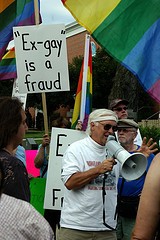 Last week the APA released a new report regarding sexual orientation change efforts (SOCE), more commonly known by some of its more common forms such as conversion therapy, reparative therapy or ex-gay ministries.
Last week the APA released a new report regarding sexual orientation change efforts (SOCE), more commonly known by some of its more common forms such as conversion therapy, reparative therapy or ex-gay ministries.
The Report of the American Psychological Association Task Force on Appropriate Therapeutic Responses to Sexual Orientation looks at a variety of published research findings from the 60’s through 2007 in an effort to evaluate the effectiveness and/or potential harm caused by the programs in question.
Among their findings:
- There is insufficient evidence that therapies to change sexual orientation actually work.
- There are reports of adverse effects from these therapies, including iatrogenic effects (meaning, introduced by the doctor), including loss of all sexual feeling, depression, anxiety, and suicidality.
Practitioners are advised to avoid telling clients that they can change their orientation through therapy. Rather, they should attempt to help their patients through therapies that include acceptance, exploration of identity, and development without attempting to reach a preconceived outcome. In other words, if a person turns out to be straight, that’s great, but conversion should not be the goal of therapy.
Because many folks who try to change their orientations are doing so due to conflicts with religious beliefs, the report also makes recommendations about helping affected people to find acceptance through welcoming communities, whether ethnic, social or religious. Such interactions can help to reduce the effects of isolation, rejection and lack of role models. The report is careful to point out that practitioners are not to discriminate against those of particular religious beliefs, but rather should take into account the person’s values and sensibilities as a part of their treatment.
Why does it matter?
Over the past couple of years in seminary I’ve had several alarming discussions concerning whether it is appropriate for a pastor to make a referral to ex-gay therapies when a parishioner comes calling, concerned over issues of orientation. The argument offered to our students goes something like this:
If sexual orientation is not binary, but rather a scale, then anyone who possesses even a point or two of heterosexual attraction/activity can work with this in order to overcome same-sex behavior/attraction. If the parishioner is uncomfortable with his or her homosexuality and has any potential to work with, then ex-gay ministries may prove helpful.
What this means is that we are teaching future pastors that if a person is not a perfect 6 on the Kinsey scale (exclusively homosexual), then a viable option might be to suggest some form of SOCE in order to alleviate the distress caused by the conflict between the person’s same-sex attractions and his/her religious beliefs. While I’m sure that the professor’s intent was good, this argument is much too nuanced (and, as far as I’m concerned, flawed). Most folks in the classroom simply hear that ex-gay therapies are endorsed by our instructors as a legitimate method for achieving heterosexual orientation.
I’m not suggesting that a person experiencing same-sex attraction is automatically gay or lesbian. In fact, the APA report even indicates that patients who explore and accept their same-sex attractions may not necessarily identify as gay, lesbian or bisexual in the end. As far as I’m concerned, that’s fine. I’m not an essentialist when it comes to orientation. I believe that while attractions themselves are not really up for debate, how we choose to express ourselves is definitely a matter of choice. And if a same-sex attracted person finds herself able to accept her attractions, but still doesn’t feel the need to call herself a lesbian or even bisexual, that’s really her own business and I support her right to defy externally-imposed labels and be whoever she chooses. The same goes for the man who is attracted to other men but chooses not to identify as gay.
It was Virginia Mollenkott‘s work in exposing the array of sexual variations that do not fit the culturally-imposed male/female paradigm that first helped me to see that there are a lot of areas in life that don’t fit nicely in the boxes. Mollenkott has written and spoken extensively about the ways in which our society takes our gender-ambiguous members and forces them into a paradigm with only two options. Regardless of the vast array of external genitalia configurations, chromosomes, gonads, hormones, and/or self-perceived gender, everyone ends up as either male or female — a determination primarily based on what the doctor sees between a baby’s legs at birth. But the truth of the matter is there’s a lot more diversity in human gender than our birth certificates allow for.
In an analogous way, I believe that as a culture we’re much to fixed on ideas of pegging everyone as gay or straight. But sometimes "gay" and "straight" just don’t fit, and we owe it to ourselves and to others to create safe space in which folks can explore their own attractions and reach their own conclusions about what they want to be called. That’s what being "queer" is all about — we don’t have to fit into any normative categories.
But I digress… The point here is that we have an augmentation of previous statements by the APA and I hope that folks are listening. For too long the stress induced by trying to live up to unrealistic expectations of sexual identity and heter-normative expectations has been wreaking havoc with people who don’t fit the mold. While churches continue to debate full inclusion of LGBT people, suicides and lynchings keep racking up. It’s time to put the ex-gay myth behind us and look for ways of exploring healthy sexuality, straight and gay and whatever else. Enough is enough already…